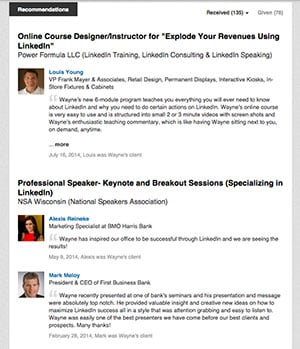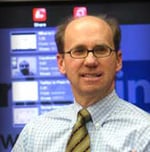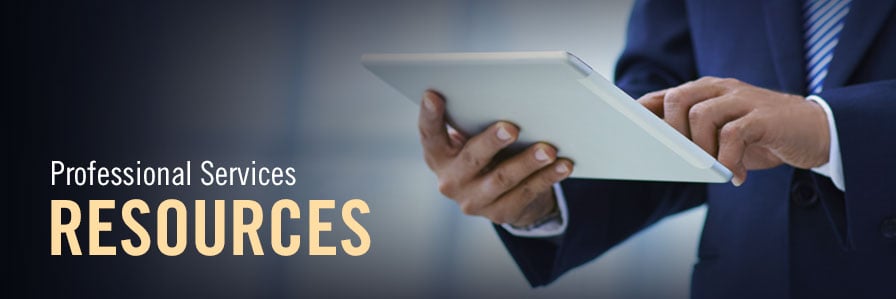In August 1997, Tom Peters (coauthor of the blockbuster book In Search of Excellence) first introduced the idea of personal branding in Fast Company Magazine with his article The Brand Called You. Check it out. It’s still a great read.
Fast forward to the present day. Your personal brand is more important than ever, and there are some great resources out there to help you improve your brand. LinkedIn is arguably the best and easiest way to share your expertise and build your reputation with the people who matter most—the clients or customers who will help you take your business to the next level.
What is a personal brand?
Dan Schawbel in his New York Times best-selling book Me 2.0: 4 Steps to Building Your Future states:
"Personal branding describes the process by which individuals and entrepreneurs differentiate themselves and stand out from the crowd by identifying and articulating their unique proposition, whether professional or personal, and then leverage it across platforms with a consistent message and image to achieve a specific goal. In this way individuals can enhance their recognition as experts in their field, establish reputation and credibility, advance their careers, and build self-confidence."
"If that definition seems confusing, it can be boiled down to this: how we market ourselves to others. You need to approach your career in terms of differentiation (standing out in the crowd) and marketability (providing something other people want or need). Why would someone choose your brand? Because you have:
- A robust professional network
- Endorsements from respected colleagues
- Previous accomplishments with cataloged results
- A diversified and unique skill set."
Let’s review these four important aspects of your personal brand and see how LinkedIn can help you create them simply and effectively.
1. Robust professional network
LinkedIn’s research indicates networking—meeting new professionals in the interest of helping or working with each other—is the number one reason people use LinkedIn. In The Start-up of You, a book coauthored by the founder of LinkedIn, Reid Hoffman writes that networking has been replaced by intelligent network building.
Your network is comprised of your personal friends, past and present coworkers, fellow club members and alumni—people who help make your life interesting, productive, and fun. Your network has always been important to you, but online tools such as LinkedIn make your network even more vital. LinkedIn refers to these "go to" people in your life as connections.
How you build a robust professional network on LinkedIn depends on your personal strategy. But bear in mind that the dictionary definition of "robust" does not mention anything about quantity. Instead, it uses words and phrases such as "strong and healthy" and "rich and full-bodied."
In general, I suggest you build the largest network you can assemble on LinkedIn but with the caveat of including only those individuals you already know and trust plus those you have strategically decided to include.
Strive to develop a rich and diverse network that includes people you can count on for help as well as a diverse cross section of people in various industries, disciplines, and geographic regions.
Invite people to join your network by using the following LinkedIn tools:
- Who’s Viewed Your Profile. When you see that someone has taken a look at your profile, send a personalized connection request if the person looks like he/she would be a good addition to your network.
- People You May Know. LinkedIn suggests new connections based on your current relationships, schools you’ve attended, experiences you’ve listed in your profile, etc.
- Alumni. Search your classmates by region, company, and job function.
- Advanced People Searching. By using LinkedIn’s wide array of search criteria— such as keywords, company, school, industry, and geographic area—you can identify potential new connections.
- Colleagues – Find past coworkers who are LinkedIn members and may be interested in connecting with you.
Join and be active in LinkedIn groups. It’s a great way to meet new people, and you can directly contact anyone in these groups. Join discussions to show your expertise and raise your visibility. Look for these types of groups:
- Those related to your industry
- Those related to your customers’ industries
- Birds of a feather (alumni, clubs, religious groups, political organizations, and hobbies)
- Those based on a city, state or region
- Those related to new skills
2. Endorsements from respected colleagues
 This is not to be confused with LinkedIn’s Skills feature, where fellow LinkedIn members can endorse you for the skills you possess with the touch of a button. In his book, Dan Schawbel was referring to traditional written recommendations.
This is not to be confused with LinkedIn’s Skills feature, where fellow LinkedIn members can endorse you for the skills you possess with the touch of a button. In his book, Dan Schawbel was referring to traditional written recommendations.
Letters of recommendation have always been an important way to display and share other people’s opinions about you, the quality of your work, and your expertise. These endorsements can quickly advance your personal brand because the recommendations you receive on LinkedIn can be seen by LinkedIn members worldwide.
Recommendations are outside corroboration of the expertise you have detailed in your profile, and they are especially important because nearly everything else in your profile has been written by you.
For maximum benefit, include several detailed recommendations for each job and educational experience outlined in your LinkedIn profile. If you have hard copies of recommendation letters written by people who have not joined LinkedIn, you can include those letters in your LinkedIn Professional Gallery.
Keep in mind that Schawbel doesn't simply refer to endorsements but also adds the words "from respected colleagues." Seek recommendations from the best names in the business, if possible. Recommendations from well-known people at respected companies encourage the reader of your profile to say, Wow—if this person took care of that company, he sure should be able to take care of me.
3. Previous accomplishments
Outline your accomplishments and catalog your results by strategically including narratives and lists in your LinkedIn profile. But don’t simply upload your resume. Your LinkedIn profile is meant to be so much more. I typically refer to it as your resume on steroids.
To enhance and protect your brand, be certain the information is accurate, complete, and interesting. To determine what information to include on your profile, ask yourself these two questions:
- Will it add to my credibility and help tell my professional story?
- Will it help more people find me after they search on LinkedIn?
If the answer to either of these questions is "yes," I suggest you include that information.
To see how your brand stacks up against other respected people in your industry, check out their profiles. This may bring to light information you forgot to include in your profile. In addition, after you’ve reviewed those profiles, ask yourself, If I were comparing them to me, would I pick me? If not, get busy and include additional accomplishments and results.
Your profile is being read by people who represent many different potential opportunities. Because you don’t know what aspect of your profile may ring true with LinkedIn readers, you want to include a broad variety of information in your profile. Here are some suggestions:
- Use the Summary, Job Experiences, Educational Experiences, Volunteer Experiences & Causes, Certifications, and Honors & Awards sections of your profile to share stories about specific accomplishments as well as details on the actual results you have achieved.
- Use the Professional Gallery section on your profile to upload or link to articles you have authored or in which you’ve been referenced, checklists, white papers, presentations, videos, etc.
4. A diversified and unique skill set
A skill is the ability to perform something well because of your knowledge, practice, and aptitude.
People often tell me they don't feel their skill set is particularly unique. My encouragement to them—and you—is that no one has what you have, and the combination of your unique and diverse skills might be just what someone is looking for in a vendor, supplier or employee.
If you need assistance to identify your special skills, ask some of your closest connections what they think makes you unique in the marketplace. Then return the favor and share with them how you view their expertise.
Because LinkedIn is—in its simplest terms—a search engine, it looks for keywords. Therefore, to be found by the people who might be looking for someone with your background and expertise, it’s important to include the most important words in your profile. Describe your skills with industry-specific terms—such as income tax preparation (for accountants) or loss prevention (insurance agent)—to improve your chances of being found.
Other ways to display your unique skill set include:
- Adding the LinkedIn profile section called Skills, where you can include up to fifty skills. LinkedIn has suggested these skills are given additional search weighting.
- Adding other optional profile sections as appropriate: Publications, Certifications, Courses, Languages, Projects, Patents, and Test Scores.
Developing a comprehensive and compelling LinkedIn profile, as well as consistently improving and expanding your network, will help you build a powerful personal brand that can open doors and provide a lifetime of success.
About Wayne Breitbarth
 Wayne is a nationally recognized industry leader in LinkedIn training and marketing and author of the best-selling book The Power Formula for LinkedIn Success. He works with companies to develop a comprehensive strategy for using LinkedIn to increase sales, raise brand awareness, recruit employees and reduce recruiting fees, and discover new markets for products and services.
Wayne is a nationally recognized industry leader in LinkedIn training and marketing and author of the best-selling book The Power Formula for LinkedIn Success. He works with companies to develop a comprehensive strategy for using LinkedIn to increase sales, raise brand awareness, recruit employees and reduce recruiting fees, and discover new markets for products and services.
Wayne’s online training course, Explode Your Revenues Using LinkedIn, has received rave reviews. For more details, visit www.powerformula.net/explode.




